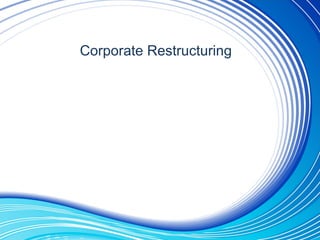
Corporaterestructuring
- 2. INTRODUCTION: Corporate Restructuring is the process of redesigning one or more aspects of a company. The process of reorganizing a company may be implemented due to a number of different factors, such as positioning the company to be more competitive, surviving a currently adverse economic climate, or acting on the self confidence of the corporation to move in an entirely new direction.
- 3. • Before restructuring there must be an existing structure which may have many limitations/ restrictions such as finance, legal, business and management which are to be kept in mind before restructuring. In other words restructuring could be considered as making alterations to some extent to the existing structure. Corporate Restructuring may have a single objective or multiple objectives; amongst them, there must be a dominant objective in addition to other important objectives for a successful corporate restructuring.
- 4. Corporate Restructuring: Meaning • It is a process by which an organization drastically alters its capital structure, asset mix and organization for increasing the firm’s value and performance .
- 5. OBJECTIVES • 1. Positioning the business to be more competitive . • 2. Surviving in an adverse economic climate. • 3. Taking the business in an entirely new direction. • 4. Restructuring of Debt. • 5. Rehabilitation of Business • 6. Inviting new partners or Private Equity. • 7. Settling Family Disputes or Family Arrangements • 8. Succession planning.
- 6. • 9. Division of Assets among Promoters-Asian Hotels • 10. Growth • 11. Technology • 12. Government policy • 13. To reduce dependency on others • 14. Economic stability
- 7. Reasons for Capital Restructuring • Globalization • Takeover of Sick • Liberalization Companies • Privatization • Strategic Tax • Development in IT Planning • • Reduction of Cost of Core Competence Capital • Rationalization • Competition • Economy of Scale • Supply Chain • Diversification Management
- 8. KINDS/ FORMS OF CORPORATE RESTRUCTURING: • 1. Portfolio Restructuring • 2. Financial Restructuring • 3. Organizational Restructuring
- 9. Methods of Restructuring • Merger/Amalgamation Holding Company • Consolidation Reverse Merger • Acquisition • Take-over • Joint Venture • Divestiture • Leveraged Buy-out • Management Buy-out
- 10. I Merger/Amalgamation • It is a process by which one firm acquires assets and liabilities of another firm in such a way that the latter firm ceases to exist e.g. HDFC Bank & Centurion Bank of Punjab in 2008 . • It is cheaper and less time consuming and procedure ridden than buying individual assets . • It must be approved by either 2/3 majority or ¾ majority .
- 11. II Consolidation • It is a business combination by which both the acquiring firm and acquired firm lose their identities and create a new firm . • E.g. Centurion Bank and Bank of Punjab creating Centurion Bank of Punjab in 2007 .
- 12. III Acquisition • It is a process by which one firm purchases substantial percentage of shares of another firm from the open market or directly from the shareholders through a tender offer . • The target company or its promoters or its managers do not come into the picture . • No formalities need be fulfilled by the target company . • It is between the Acquiring Firm and the shareholders of the Target Company .
- 13. IV Take-over • It is a process by which control of a corporate is transferred from one group of promoters to another group . • Cash or securities may be paid for the transfer . • A situation in which one company takes control of another compa ny by buying a majority of its shares a takeover bid (=an offer to pay a particular amount in order to get control of a company):Shareholders have accepted a takeover bid. • E.g. ADAG (Anil Dhirubhai Ambani Group) taking over Adlabs in 2007 from the promoter Manmohan Shetty .
- 14. V Joint Venture • It is a form of business combination in which two different firms contribute financial, production, organisation/marketing skills to form a new company or to carry out a particular economic activity . • E.g: 1. Bharti Televenture has a JV with Nokia for its network maintenance, another JV with Nokia for marketing the handsets of Nokia . 2. Sony-erricson.
- 15. VI Divestiture • Divestiture is the sale of a segment of a company to a third party. • The segment may be assets, product lines, subsidiaries or divisions . • The sale may be for cash or securities .
- 16. VII Leveraged Buyout • LBO is ,” the acquisition, financed largely by borrowing, of all the stock, or assets of a public company by a small group of investors”- Weston • The acquisition of another company using a significant amount of borrowed money (bonds or loans) to meet the cost of acquisition. • In an LBO, there is usually a ratio of 90% debt to 10% equity.
- 17. VIII Management Buy-Out • MBO is a process by which the substantial part of the shares of the company are purchased by the Executives of the company from the promoters . • When the promoters are planning to sell a firm, the managerial personnel may buy the same from the promoters .
- 18. XI Strategic Alliance • It is an agreement among two or more firms to co-operate in order to achieve a commercial objective . • In the form of JV, Franchising, Supply Agreement, Purchase Agreement, Marketing Agreement, Technology Supply Agreement, Technical Support Agreement etc. • Based on trust and preset priorities .
- 19. LIMITATIONS OF CORPORATE RESTRUCTURING: • (a) Inadequate commitment from top management • (b) Resistance to change • (c) Poor communication • (d) Absence of required skills • (e) Failure to understand the benefits of restructuring • (f) lack of resources • (g) Organizational workload • (h) lack of visible and clear leadership
- 20. THANK YOU